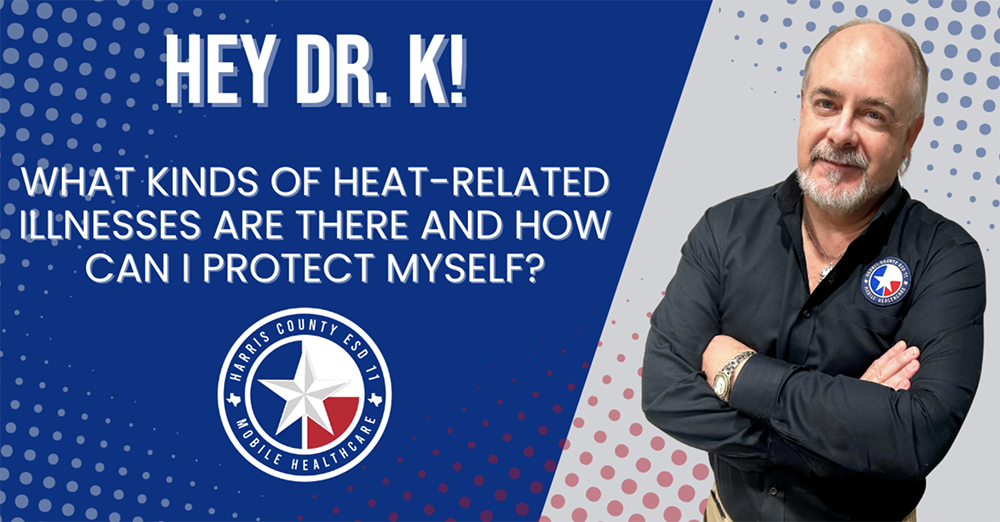
How to Prevent Heat Stroke and Illness: ESD 11 Medical Director Shares Summer Safety Tips for Champions Park Residents
With triple-digit temperatures and high humidity settling in across Southeast Texas, health officials are urging residents to be vigilant about the dangers of heat-related illness. For those living in Champions Park and surrounding areas served by Harris County Emergency Services District 11 (ESD 11) Mobile Healthcare, expert advice comes directly from the district’s medical director, Dr. Jay Kovar.
“There are about 7,000 emergency visits a year due to heat-related illness and about 700 deaths,” Dr. Kovar recently told a group of teens participating in a summer lunch-and-learn session. “Texas, California, and Arizona lead the nation in the number of incidents.”
Recognizing the Signs of Heat-Related Illness
As Dr. Kovar explained, heat-related illnesses can range from mild conditions such as heat rash or swollen feet to serious medical emergencies like heat stroke. Early symptoms often include dizziness, nausea, and muscle cramping — warning signs that your body’s core temperature may be reaching unsafe levels.
“Muscle weakness and spasms, cramping, and lightheadedness are all indicators that your body’s core temperature is reaching dangerous levels,” he said. “It is a very short window from heat exhaustion to heat stroke. Know the signs and know what to do to protect yourself.”
Mobile Sidebar Ad
The Centers for Disease Control and Prevention (CDC) reports that heat is the leading cause of weather-related deaths in the United States, with older adults, children, and people with chronic illnesses being particularly vulnerable. According to Harris County Public Health, local emergency departments treated over 1,100 people for heat-related illnesses during the 2023 heat wave alone — a number expected to rise as extreme heat events become more frequent.
Key Prevention Tips from ESD 11
Dr. Kovar emphasized that even healthy, active adults are not immune to the effects of summer heat, especially if they aren’t properly acclimated. “Your body takes about two weeks through a hormonal process to get you ready for the summer temperatures, so take it easy on yourself when you go outside,” he advised.
To stay safe, Dr. Kovar recommends:
- Wearing light-colored, loose-fitting clothing
- Drinking plenty of water throughout the day
- Avoiding strenuous outdoor activity during peak heat hours (typically 11 a.m. to 4 p.m.)
- Seeking shade or indoor air conditioning at the first signs of heat-related symptoms
And despite common myths, he was clear on one point: “It is a myth that you should gradually return to air-conditioned spaces after working in the heat. The best course of action if you get overheated is to immediately cool your body temperature down through any means available.”
Community Healthcare with a Mission
Serving a 177-square-mile region in northern Harris County, ESD 11 Mobile Healthcare responds to over 65,000 calls annually and is the largest emergency services district in Texas. Their commitment to quality care and rapid response has earned national recognition, including ACE (Accredited Center of Excellence) status from the International Academies of Emergency Dispatch.
This summer, Dr. Kovar and the ESD 11 team are committed to raising awareness and preventing avoidable heat-related tragedies. Community members are encouraged to call 281-524-7660 with questions or for additional resources. And as always, in an emergency, dial 911.
For ongoing public safety updates and health alerts, stay connected with My Neighborhood News.
 Tiffany Krenek has been on the My Neighborhood News team since August 2021. She is passionate about curating and sharing content that enriches the lives of our readers in a personal, meaningful way. A loving mother and wife, Tiffany and her family live in the West Houston/Cypress region.
Tiffany Krenek has been on the My Neighborhood News team since August 2021. She is passionate about curating and sharing content that enriches the lives of our readers in a personal, meaningful way. A loving mother and wife, Tiffany and her family live in the West Houston/Cypress region.


